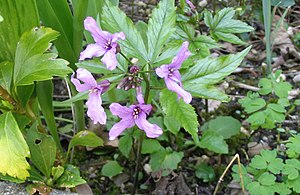Finger tooth root
| Finger tooth root | ||||||||||||
|---|---|---|---|---|---|---|---|---|---|---|---|---|

Finger tooth root ( Cardamine pentaphyllos ) |
||||||||||||
| Systematics | ||||||||||||
|
||||||||||||
| Scientific name | ||||||||||||
| Cardamine pentaphyllos | ||||||||||||
| (L.) Crantz |
The finger tooth root ( Cardamine pentaphyllos ) is a 20–50 cm high, deciduous geophyte with a horizontally creeping, fleshy rhizome .
There are usually 3 alternate stem leaves, the lower ones being fingered with five fingers, while the upper one is fingered with three fingers. The leaflets are lanceolate to ovate and serrated.
The flower cluster usually consists of 8–17 flowers that tower above the leaves. The 15-25 mm long petals are usually purple. The sepals are 7-10 mm long and have a purple skin edge.
The pods are 4-7 mm long and 3-4 mm wide and pointed by a 7-10 mm long style. The pod stalks are 10–35 mm long and stand horizontally.
The species has chromosome number 2n = 48.
ecology
The finger-tooth root is a shade-bearing, more or less montane growing forest plant. They bloom between April and June. There is insect pollination and self-pollination instead. The seeds ripen mostly in August. The seeds are thrown at maturity by rapid rolling of the flaps from the bottom upwards. The leaves stay green until September or October. The vegetative reproduction is possible by dividing the rhizomes. The seeds can only germinate in soils containing litter.
General distribution
The finger tooth root is a western alpine flora element. Its distribution area includes the Pyrenees, Cevennes, Vosges, the Alps, the Alpine foothills, the Black Forest, the Swabian Southwest Alb as well as the French and Swiss Jura.
Locations
The finger tooth root needs well-infiltrated, nutrient-rich, humus-rich, stony loamy soil that can even be slightly acidic, but which should have a good layer of mulch. It inhabits ravine forests, especially the Fraxino-Aceretum-pseudoplatani and herb-rich, moist deciduous forests. Very rarely, but often in loose, sometimes in individual populations, you can find them in Germany on the Baar, on the Upper Rhine, in the Hegau and in the foothills of the Alps. The plant hardly rises up to 1500 m.
literature
- Oskar Sebald, Siegmund Seybold, Georg Philippi (Hrsg.): The fern and flowering plants of Baden-Württemberg . Volume 2: Special part (Spermatophyta, subclass Dilleniidae): Hypericaceae to Primulaceae. 2nd expanded edition. Eugen Ulmer, Stuttgart 1993, ISBN 3-8001-3323-7 .
- Otto Schmeil , Jost Fitschen (greeting), Siegmund Seybold: The flora of Germany and the neighboring countries . A book for identifying all wild and frequently cultivated vascular plants. 95th completely revised u. exp. Edition. Quelle & Meyer, Wiebelsheim 2011, ISBN 978-3-494-01498-2 .
- Henning Haeupler, Thomas Muer: Illustrated atlas of fern and flowering plants Germany s. 2nd Edition. Eugen Ulmer, Stuttgart 2007, ISBN 978-3-8001-4990-2 .
- Dietmar Aichele, Heinz-Werner Schwegler: The flowering plants of Central Europe , Franckh-Kosmos-Verlag, 2nd revised edition 1994, Volume 3, ISBN 3 440-08048-X
Individual evidence
- ↑ a b c Erich Oberdorfer : Plant-sociological excursion flora for Germany and neighboring areas . 8th edition. Stuttgart, Verlag Eugen Ulmer, 2001. Page 462. ISBN 3-8001-3131-5
Web links
- Finger tooth root. In: FloraWeb.de.
- Distribution map for Germany. In: Floraweb .
- Cardamine pentaphyllos (L.) Crantz In: Info Flora , the national data and information center for Swiss flora . Retrieved October 28, 2015.
- Thomas Meyer: Data sheet with identification key and photos at Flora-de: Flora von Deutschland (old name of the website: Flowers in Swabia )